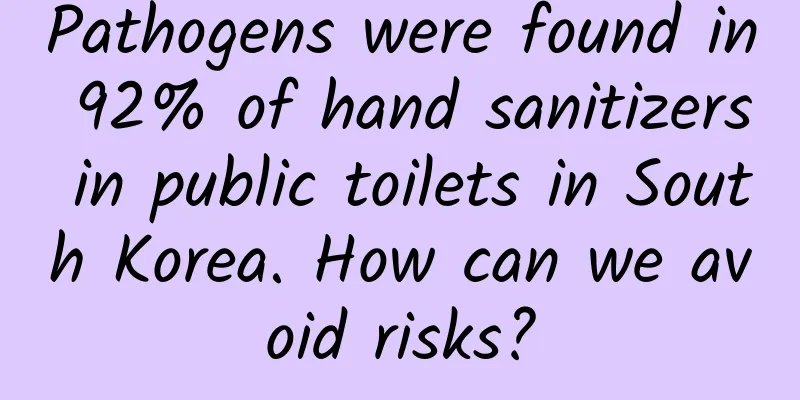Pathogens were found in 92% of hand sanitizers in public toilets in South Korea. How can we avoid risks?

|
Myth: A South Korean research team found that hand sanitizer in public restrooms is not hygienic, but may be "full of germs." Real points: The process of repeatedly refilling hand sanitizer may cause the hand sanitizer to be contaminated with bacteria. Automatic dispensing hand sanitizer should be used as much as possible. If you are in a public place, do not use bottled hand sanitizer. You should not try to make your own hand sanitizer at home. Verifier: Olibo丨Trauma and Emergency Medicine Consultant Since the outbreak of the COVID-19 pandemic, people's awareness of hygiene has generally increased, and many people will repeatedly wash their hands with hand sanitizer in public toilets to ensure cleanliness. However, according to recent reports by Korean media, hand sanitizers placed in public places are not hygienic, but may be "covered with bacteria." The report said that a research team from Chungbuk University of Health Sciences in South Korea tested hand sanitizers in public toilets in Cheongju City and found pathogens in 92% of the hand sanitizers. Why does hand sanitizer, which is supposed to kill bacteria, have the opposite effect? How can we wash our hands cleanly and hygienically? 1. The main component of hand sanitizer is surfactant, which may cause bacterial contamination during filling Currently, hand sanitizers are mainly divided into two categories: water-washable hand sanitizers and hand-free disinfectants. The main component of water-washing hand sanitizer is surfactant, which can help remove dirt and most bacteria on the hands, and washing with water foam can remove dirt together. Some water-washing hand sanitizers also add antibacterial ingredients, such as triclosan, triclocarban, benzalkonium chloride, benzethonium chloride and chlorocresol (PCMX). In 2016, the U.S. Food and Drug Administration (FDA) banned the sale of hand sanitizers containing antibacterial ingredients to the public because they were no better than regular hand sanitizers and could lead to increased bacterial resistance. However, antibacterial hand sanitizers are still used in medical settings. The main ingredients of hand sanitizer are ethanol, propanol and other ingredients, and the principle is to kill bacteria within tens of seconds. Hand sanitizers used in medical environments may also have antibacterial ingredients added, such as chlorhexidine, which will help maintain antibacterial activity for several hours after washing hands. So why does the hand sanitizer used for sterilization and disinfection still contain bacteria? In fact, whether it is water-washable hand sanitizer or hand-free disinfectant, it has undergone a sterilization procedure before leaving the factory, so the content of pathogenic microorganisms in the newly purchased hand sanitizers is close to 0. However, the process of repeatedly filling hand sanitizer may cause bacterial contamination. From the time the hand sanitizer package is opened to the time it is poured into a specific container, the hand sanitizer distribution container is contaminated, it contacts unclean surfaces during filling, and the operator's hands are unhygienic, all of which may cause the hand sanitizer to be contaminated. Hand sanitizer exposed to the air may also be contaminated by microorganisms in the air. Therefore, it can be inferred that the pathogens detected in the hand sanitizers reported by the Korean media are due to the above reasons - those hand sanitizers are continuously poured into the hand washing device at a later stage. In addition, homemade or self-prepared hand sanitizers (such as alcohol) can also cause bacterial contamination, so you should not try to make your own hand sanitizer at home. 2. Using hand sanitizers with excessive bacteria may cause group infection risks. It is not recommended to use bottled hand sanitizers in public places. There have been several outbreaks of pathogens associated with contaminated hand sanitizers in healthcare settings. In one case, five infants in the neonatal intensive care unit (NICU) developed Serratia marcescens infections, which were suspected to be caused by contamination from hand sanitizer dispensers. Although there are no reports of group infection caused by contaminated hand sanitizers in public places, the risk still exists in public places outside hospitals, such as public toilets, where large-capacity, refillable hand sanitizers are the main type of hand sanitizers. A study in Japan evaluated the bacterial contamination of hand sanitizers in public restrooms. The researchers found 17 different bacteria in hand sanitizers, many of which were opportunistic pathogens, including Klebsiella pneumoniae, Serratia marcescens, Escherichia coli, and Pseudomonas. These pathogens are not pathogenic when they parasitize healthy hosts with normal immune function, but they will invade and cause symptoms when the host is immunocompromised. A study in the United States showed that 25% of refillable hand sanitizer dispensers in public toilets were significantly contaminated, with an average bacterial load of more than 106 CFU/ml (the total number of bacterial colonies contained in each milliliter of sample), and 16% of the samples contained Escherichia coli. A 2011 study suggests that the contamination of hand sanitizer in schools can lead to an increase in the amount of bacteria remaining on hands after washing. In the study, students and teachers participated in the experiment on a voluntary basis. Compared with before washing hands, the bacterial load on the hands of students and teachers increased 26 times after washing hands with contaminated hand sanitizer. However, using uncontaminated hand sanitizer will reduce the bacterial load on the hands. The researchers speculate that this may lead to an increased risk of infection in specific groups, making hand washing no longer effective or even a new way of microbial contamination. 3. Keep the following points in mind to reduce the risks associated with hand sanitizer Compared with water-based hand sanitizers, the risk of contamination of alcohol-based hand sanitizers is relatively small. Even so, the use of contaminated alcohol-based hand sanitizers may still cause microbial transmission and bacteremia. Contamination incidents with alcohol-based hand sanitizers may be due to the uncleanness of the prepared alcohol itself or the uncleanness of the water used for dilution. Therefore, homemade alcohol-based disinfectants should not be made at home. The Centers for Disease Control and Prevention in the United States explicitly recommends not to refill hand sanitizers, and many hand sanitizer manufacturers also recommend not to do so. Commercial refill hand sanitizers (including water-washable and disposable) are usually fully installed, and if they are replaced correctly according to the manufacturer's recommendations, there is generally no need to worry about the risk of infection. In addition, solid soap is not recommended. Many families use solid soap to wash their hands, but the surface of solid soap may become a breeding ground for pathogenic microorganisms. When washing hands, you should rub them for at least 20 seconds each time, and then rinse your hands with water. After washing your hands, you should dry your hands with a paper towel or a dryer, because wet hands are more likely to spread bacteria and other microorganisms. As for hand sanitizer, you should use automatic dispensing hand sanitizer as much as possible. If you are in a public place, do not use bottled hand sanitizer. If you need to replace the refill, try to choose sealed hand sanitizer. Do not make or configure your own hand sanitizer, whether it is hand sanitizer or water-washable hand sanitizer. Editor of this article: ambergchen |
<<: Why do macadamia nuts have a crack? What should I do if the macadamia nut is not cracked?
>>: How to eat macadamia nuts? Macadamia nuts are good for the skin
Recommend
Causes and treatment of leg edema in pregnant women
Pregnant women's legs often have edema. Do yo...
Female genital beauty
When girls reach a certain age or have had childb...
Bleeding after having sex after menstruation
Bleeding after having sex right after the menstru...
What are the benefits of eating chrysanthemum? Who is suitable to eat chrysanthemum?
Chrysanthemum is a one- to two-year-old herbaceou...
Breast cancer stage 6
Breast cancer is a disease with an increasing inc...
How to maintain the uterus?
Usually, we pay attention to various ways, such a...
What is the reason why women have dimples on their waists?
I believe that most women would like to have dimp...
How long is the normal due date?
We all know that women have a due date when they ...
Can pregnant women get massage?
Nowadays, many pregnant women know how to take ca...
Why walking helps with childbirth
When the cervix is dilated to 3 fingers, the do...
Semiconductor Industry Association: Global chip sales in Q2 2015 were $84 billion, up 2% year-on-year
The Semiconductor Industry Association reported t...
What are the dangers of crying during confinement?
The nervous system of parturient women is very se...
What is the 9-valent human papillomavirus vaccine?
The nine-valent HPV vaccine has good antigenicity...
What are the symptoms of endocrine disorders in girls
Endocrine disorders are a very common disease. Mo...
What are the harms of musk to women?
Musk is a traditional Chinese medicinal material....








![[Fat Bear Science] Do you like hot food? Do you like hot tea? Do you love spicy food? Beware that this cancer is caused by eating](/upload/images/67f1ecbae09d8.webp)
